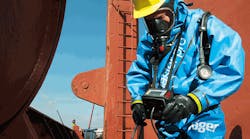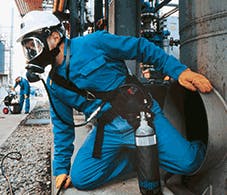In high-risk industries such as oil and natural gas, chemical and pulp and paper, it is crucial that each worker be equipped with the appropriate respirator and working knowledge of the recommended and mandated safety protocols to maximize protection against life-threatening gases, like hydrogen sulfide (H2S). In fact, the U.S. Bureau of Labor Statistics reports that between 2003 and 2012, 64 injuries occurred as a result of H2S, making it one of the leading causes of fatal occupational injuries in the workplace.
While the primary goal of protecting workers from H2S should be to prevent its release, a number of considerations must be evaluated before determining the best respirator for the work at hand.
The saying, "The best defense is a good offense" certainly is applicable when it comes to protecting a company's most valuable assets – its workers – from an H2S event.
Employers should follow at least three of OSHA's guidelines for personnel working with any hazardous process (OSHA 29 CFR 1910.110 Appendix C {Compliance Guidelines and Recommendations for Process Safety Management}), and implement them simultaneously to minimize the risk of a leak:
Containment: Use standard operating procedures (SOPs) and engineering controls designed to control all hazardous substances. For example, keep it contained by using approved devices, piping, values and process design specifications.
Back-up controls: Control or mitigate exposure to workers and the environment in the event that the first line of defense is compromised or fails. For example, control the substance with relief valves, scrubbers, flares, surge/overflow tanks, fire suppression systems, etc.
Emergency response: Protect plant and human assets by providing a means of escape/response in the event that containment and back-up controls fail. For example, depending on the situation, this can range from a simple evacuation plan to a complex emergency response, including escape respirators, etc.
Unfortunately, the emergency response component too often is overlooked, as an escape respirator may be viewed as redundant since it cannot physically prevent H2S from occurring. Still, to effectively guard against an emergency situation or day-to-day risk, companies must arm their workers with tools that will help ensure their safety.
Respirators should be viewed as supplements to the guidelines and standards from NIOSH, OSHA and ACGIH that are designed to protect workers against hazardous environments containing H2S. To appropriately ascertain what may be required of a respirator, a smart first defensive step would be for companies to establish which of the worksite's areas pose a threat through risk assessments and testing.
Pinpointing Onsite Risks
Each worksite has a unique set of challenges; therefore, companies should conduct a risk assessment to tailor their preventive measures to their specific needs. Given the varying health problems or fatalities environments containing concentrations of H2S can produce, it is essential to identify all potential sources of risk on the worksite.
According to EPA, the deadly gas forms naturally 90 percent of the time, resulting in it commonly being found at crude petroleum and natural gas deposits or stagnant bodies of water. Man, too, is capable of making H2S, which is often the case in the aforementioned high-risk industries. With this in mind, companies should carry out additional analyses for each subsequent change in process or equipment, in addition to an initial worksite analysis.
To aid in the risk assessment process, the following pre-defined checklist of criteria can be referenced, such as the NIOSH Respirator Selection Logic:
- General use conditions, including determination of contaminant(s);
- Physical, chemical and toxicological properties of the contaminant(s);
- NIOSH recommended exposure limit (REL), OSHA permissible exposure limit (PEL), American Conference of Governmental Industrial Hygienists (ACGIH) Threshold Limit Value (TLV) or other applicable occupational exposure limit;
- Expected concentration of each respiratory hazard;
- Immediately dangerous to life or health (IDLH) concentration;
- Oxygen concentration or expected oxygen concentration;
- Eye irritation potential; and environmental factors, such as presence of oil aerosols.
- Further, to supplement this investigation, companies should consider hiring a certified industrial hygienist in tandem to conduct an additional risk assessment, ensuring that all priority areas have been analyzed.
Determining the Best Fit
Equally important to examining the worksite environment for potential areas of risk is understanding the health-related issues associated with H2S exposure. Similar to most gases, the level of impact to a worker's health directly corresponds to the concentration of exposure in parts per million (ppm) and duration of exposure. For example:
- .13 ppm: The threshold of odor detection.
- 10-100 ppm: Eye and throat irritationand headaches can occur after one hour of exposure. A worker may experience nausea, dizziness, coughing and vomiting due to continued exposure.
- 700-1000 ppm: This amount of H2S can cause unconsciousness and immediate collapse within one or two breaths. Continued exposure at this amount may be fatal.
- 1000-2000 ppm: Nearly instant death occurs when exposed to this amount of H2S.
- 45,000 and 450,000 ppm: An explosion can occur at this level of exposure.
After identifying the degree of severity of a potential H2S event, the respirator selection process will then depend on the standards and guidelines of each country. For example, worksites in the United States will follow the OSHA respiratory selection regulations, which are determined by the maximum use concentration (MUC). This figure is the multiplication of the assigned protection factor (APF) and the recommended exposure limit (REL). OSHA's standard 29 CFR 1910.134 will detail the APF of a certain class of respirators and NIOSH's Pocket guide to Chemical Hazards shows exposure limits.
The following respirator types are suggested based on their corresponding concentrations of H2S:
- 0-10 ppm: No respirator is needed, below REL.
- 10-100 ppm: Powered air-purifying respirator (PAPR), full face mask cartridge respirator or self-contained breathing apparatuses (SCBA).
- 100-100,000 ppm: SCBA or supplied air in positive pressure mode.
Companies shouldn't rule out the possibility that there may be circumstances where workers could be exposed to H2S concentrations exceeding 100,000 ppm, including drilling operations or work-overs of low-producing wells. If the initial assessment identifies this scenario as a potential threat, companies can refer to the manufacturer's simulated workplace protection factor (SWPF) test. Some manufacturers have tested their respirators with sulfur hexafluoride (SF6) to replicate the safety challenges that arise during H2S exposure, finding that some SBCAs provide protection above industry standards. In these tests, 3D head scans are created, which are then used to help devise exercises that simulate escape situations, helping prepare workers for the unexpected.
Across these high-risk industries, companies can demonstrate their commitment to the safety of their workforce by proactively and intelligently identifying hazardous situations. This process is critical to the success of these businesses. It is essential that managers pledge to reduce the number of work-related respiratory injuries and invest in quality respirators to combat extreme environments.
Robb Zurek oversees strategic product and portfolio-based initiatives for the Lübeck, Germany-based company. He can be reached at [email protected].
1http://www.cdc.gov/niosh/docs/2005-100/pdfs/2005-100.pdf

